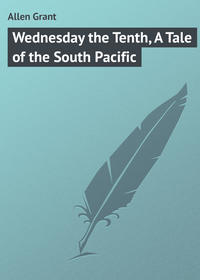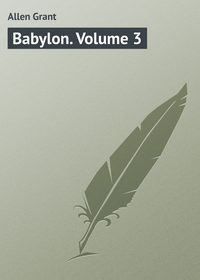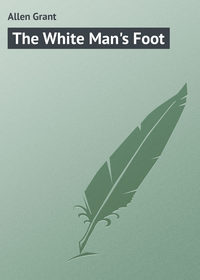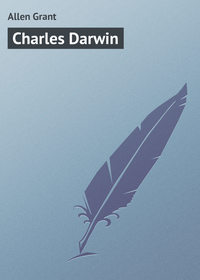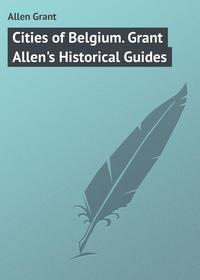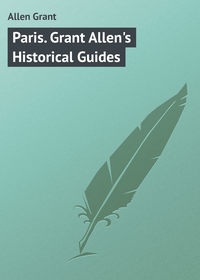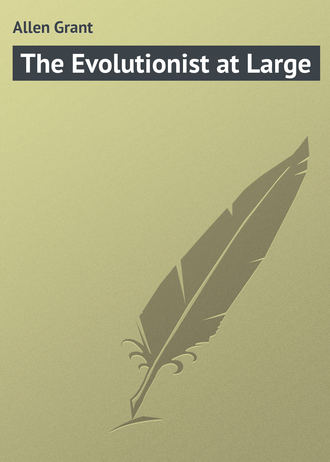 полная версия
полная версияThe Evolutionist at Large

The Evolutionist at Large
PREFACE
These Essays originally appeared in the columns of the 'St. James's Gazette,' and I have to thank the courtesy of the Editor for kind permission to republish them. My object in writing them was to make the general principles and methods of evolutionists a little more familiar to unscientific readers. Biologists usually deal with those underlying points of structure which are most really important, and on which all technical discussion must necessarily be based. But ordinary people care little for such minute anatomical and physiological details. They cannot be expected to interest themselves in the flexor pollicis longus, or the hippocampus major about whose very existence they are ignorant, and whose names suggest to them nothing but unpleasant ideas. What they want to find out is how the outward and visible forms of plants and animals were produced. They would much rather learn why birds have feathers than why they have a keeled sternum; and they think the origin of bright flowers far more attractive than the origin of monocotyledonous seeds or exogenous stems. It is with these surface questions of obvious outward appearance that I have attempted to deal in this little series. My plan is to take a simple and well-known natural object, and give such an explanation as evolutionary principles afford of its most striking external features. A strawberry, a snail-shell, a tadpole, a bird, a wayside flower – these are the sort of things which I have tried to explain. If I have not gone very deep, I hope at least that I have suggested in simple language the right way to go to work.
I must make an apology for the form in which the essays are cast, so far as regards the apparent egotism of the first person. When they appeared anonymously in the columns of a daily paper, this air of personality was not so obtrusive: now that they reappear under my own name, I fear it may prove somewhat too marked. Nevertheless, to cut out the personal pronoun would be to destroy the whole machinery of the work: so I have reluctantly decided to retain it, only begging the reader to bear in mind that the I of the essays is not a real personage, but the singular number of the editorial we.
I have made a few alterations and corrections in some of the papers, so as to bring the statements into closer accordance with scientific accuracy. At the same time, I should like to add that I have intentionally simplified the scientific facts as far as possible. Thus, instead of saying that the groundsel is a composite, I have said that it is a daisy by family; and instead of saying that the ascidian larva belongs to the sub-kingdom Chordata, I have said that it is a first cousin of the tadpole. For these simplifications, I hope technical biologists will pardon me. After all, if you wish to be understood, it is best to speak to people in words whose meanings they know. Definite and accurate terminology is necessary to express definite and accurate knowledge; but one may use vague expressions where the definite ones would convey no ideas.
I have to thank the kindness of my friend the Rev. E. Purcell, of Lincoln College, Oxford, for the clever and appropriate design which appears upon the cover.
G. A.A BALLADE OF EVOLUTION
In the mud of the Cambrian mainDid our earliest ancestor dive:From a shapeless albuminous grainWe mortals our being derive.He could split himself up into five,Or roll himself round like a ball;For the fittest will always survive,While the weakliest go to the wall.As an active ascidian againFresh forms he began to contrive,Till he grew to a fish with a brain,And brought forth a mammal alive.With his rivals he next had to strive,To woo him a mate and a thrall;So the handsomest managed to wive,While the ugliest went to the wall.At length as an ape he was fainThe nuts of the forest to rive;Till he took to the low-lying plain,And proceeded his fellow to knive.Thus did cannibal men first arrive,One another to swallow and maul;And the strongest continued to thrive,While the weakliest went to the wall.EnvoyPrince, in our civilised hive,Now money's the measure of all;And the wealthy in coaches can drive,While the needier go to the wall.I.
MICROSCOPIC BRAINS
Sitting on this little rounded boss of gneiss beside the path which cuts obliquely through the meadow, I am engaged in watching a brigade of ants out on foraging duty, and intent on securing for the nest three whole segments of a deceased earthworm. They look for all the world like those busy companies one sees in the Egyptian wall-paintings, dragging home a huge granite colossus by sheer force of bone and sinew. Every muscle in their tiny bodies is strained to the utmost as they prise themselves laboriously against the great boulders which strew the path, and which are known to our Brobdingnagian intelligence as grains of sand. Besides the workers themselves, a whole battalion of stragglers runs to and fro upon the broad line which leads to the head-quarters of the community. The province of these stragglers, who seem so busy doing nothing, probably consists in keeping communications open, and encouraging the sturdy pullers by occasional relays of fresh workmen. I often wish that I could for a while get inside those tiny brains, and see, or rather smell, the world as ants do. For there can be little doubt that to these brave little carnivores here the universe is chiefly known as a collective bundle of odours, simultaneous or consecutive. As our world is mainly a world of visible objects, theirs, I believe, is mainly a world of olfactible things.
In the head of every one of these little creatures is something that we may fairly call a brain. Of course most insects have no real brains; the nerve-substance in their heads is a mere collection of ill-arranged ganglia, directly connected with their organs of sense. Whatever man may be, an earwig at least is a conscious, or rather a semi-conscious, automaton. He has just a few knots of nerve-cells in his little pate, each of which leads straight from his dim eye or his vague ear or his indefinite organs of taste; and his muscles obey the promptings of external sensations without possibility of hesitation or consideration, as mechanically as the valve of a steam-engine obeys the governor-balls. You may say of him truly, 'Nihil est in intellectu quod non fuerit in sensu;' and you need not even add the Leibnitzian saving clause, 'nisi ipse intellectus;' for the poor soul's intellect is wholly deficient, and the senses alone make up all that there is of him, subjectively considered. But it is not so with the highest insects. They have something which truly answers to the real brain of men, apes, and dogs, to the cerebral hemispheres and the cerebellum which are superadded in us mammals upon the simple sense-centres of lower creatures. Besides the eye, with its optic nerve and optic perceptive organs – besides the ear, with its similar mechanism – we mammalian lords of creation have a higher and more genuine brain, which collects and compares the information given to the senses, and sends down the appropriate messages to the muscles accordingly. Now, bees and flies and ants have got much the same sort of arrangement, on a smaller scale, within their tiny heads. On top of the little knots which do duty as nerve-centres for their eyes and mouths, stand two stalked bits of nervous matter, whose duty is analogous to that of our own brains. And that is why these three sorts of insects think and reason so much more intellectually than beetles or butterflies, and why the larger part of them have organised their domestic arrangements on such an excellent co-operative plan.
We know well enough what forms the main material of thought with bees and flies, and that is visible objects. For you must think about something if you think at all; and you can hardly imagine a contemplative blow-fly setting itself down to reflect, like a Hindu devotee, on the syllable Om, or on the oneness of existence. Abstract ideas are not likely to play a large part in apian consciousness. A bee has a very perfect eye, and with this eye it can see not only form, but also colour, as Sir John Lubbock's experiments have shown us. The information which it gets through its eye, coupled with other ideas derived from touch, smell, and taste, no doubt makes up the main thinkable and knowable universe as it reveals itself to the apian intelligence. To ourselves and to bees alike the world is, on the whole, a coloured picture, with the notions of distance and solidity thrown in by touch and muscular effort; but sight undoubtedly plays the first part in forming our total conception of things generally.
What, however, forms the thinkable universe of these little ants running to and fro so eagerly at my feet? That is a question which used long to puzzle me in my afternoon walks. The ant has a brain and an intelligence, but that brain and that intelligence must have been developed out of something. Ex nihilo nihil fit. You cannot think and know if you have nothing to think about. The intelligence of the bee and the fly was evolved in the course of their flying about and looking at things: the more they flew, and the more they saw, the more they knew; and the more brain they got to think with. But the ant does not generally fly, and, as with most comparatively unlocomotive animals, its sight is bad. True, the winged males and females have retained in part the usual sharp eyes of their class – for they are first cousins to the bees – and they also possess three little eyelets or ocelli, which are wanting to the wingless neuters. Without these they would never have found one another in their courtship, and they would have run their heads against the nearest tree, or rushed down the gaping throat of the first expectant swallow, and so effectually extinguished their race. Flying animals cannot do without eyes, and they always possess the most highly developed vision of any living creatures. But the wingless neuters are almost blind – in some species quite so; and Sir John Lubbock has shown that their appreciation of colour is mostly confined to an aversion to red light, and a comparative endurance of blue. Moreover, they are apparently deaf, and most of their other senses seem little developed. What can be the raw material on which that pin's head of a brain sets itself working? For, small as it is, it is a wonderful organ of intellect; and though Sir John Lubbock has shown us all too decisively that the originality and inventive genius of ants have been sadly overrated by Solomon and others, yet Darwin is probably right none the less in saying that no more marvellous atom of matter exists in the universe than this same wee lump of microscopic nerve substance.
My dog Grip, running about on the path there, with his nose to the ground, and sniffing at every stick and stone he meets on his way, gives us the clue to solve the problem. Grip, as Professor Croom Robertson suggests, seems capable of extracting a separate and distinguishable smell from everything. I have only to shy a stone on the beach among a thousand other stones, and my dog, like a well-bred retriever as he is, selects and brings back to me that individual stone from all the stones around, by exercise of his nose alone. It is plain that Grip's world is not merely a world of sights, but a world of smells as well. He not only smells smells, but he remembers smells, he thinks smells, he even dreams smells, as you may see by his sniffing and growling in his sleep. Now, if I were to cut open Grip's head (which heaven forfend), I should find in it a correspondingly big smell-nerve and smell-centre – an olfactory lobe, as the anatomists say. All the accumulated nasal experiences of his ancestors have made that lobe enormously developed. But in a man's head you would find a very large and fine optic centre, and only a mere shrivelled relic to represent the olfactory lobes. You and I and our ancestors have had but little occasion for sniffing and scenting; our sight and our touch have done duty as chief intelligencers from the outer world; and the nerves of smell, with their connected centres, have withered away to the degenerate condition in which they now are. Consequently, smell plays but a small part in our thought and our memories. The world that we know is chiefly a world of sights and touches. But in the brain of dog, or deer, or antelope, smell is a prevailing faculty; it colours all their ideas, and it has innumerable nervous connections with every part of their brain. The big olfactory lobes are in direct communication with a thousand other nerves; odours rouse trains of thought or powerful emotions in their minds just as visible objects do in our own.
Now, in the dog or the horse sight and smell are equally developed; so that they probably think of most things about equally in terms of each. In ourselves, sight is highly developed, and smell is a mere relic; so that we think of most things in terms of sight alone, and only rarely, as with a rose or a lily, in terms of both. But in ants, on the contrary, smell is highly developed and sight a mere relic; so that they probably think of most things as smellable only, and very little as visible in form or colour. Dr. Bastian has shown that bees and butterflies are largely guided by scent; and though he is certainly wrong in supposing that sight has little to do with leading them to flowers (for if you cut off the bright-coloured corolla they will never discover the mutilated blossoms, even when they visit others on the same plant), yet the mere fact that so many flowers are scented is by itself enough to show that perfume has a great deal to do with the matter. In wingless ants, while the eyes have undergone degeneration, this high sense of smell has been continued and further developed, till it has become their principal sense-endowment, and the chief raw material of their intelligence. Their active little brains are almost wholly engaged in correlating and co-ordinating smells with actions. Their olfactory nerves give them nearly all the information they can gain about the external world, and their brains take in this information and work out the proper movements which it indicates. By smell they find their way about and carry on the business of their lives. Just as you and I know the road from Regent's Circus to Pall Mall by visible signs of the street-corners and the Duke of York's Column, so these little ants know the way from the nest to the corpse of the dismembered worm by observing and remembering the smells which they met with on their way. See: I obliterate the track for an inch or two with my stick, and the little creatures go beside themselves with astonishment and dismay. They rush about wildly, inquiring of one another with their antennæ whether this is really Doomsday, and whether the whole course of nature has been suddenly revolutionised. Then, after a short consultation, they determine upon action; and every ant starts off in a different direction to hunt the lost track, head to the ground, exactly as a pointer hunts the missing trail of a bird or hare. Each ventures an inch or so off, and then runs back to find the rest, for fear he should get isolated altogether. At last, after many failures, one lucky fellow hits upon the well-remembered train of scents, and rushes back leaving smell-tracks no doubt upon the soil behind him. The message goes quickly round from post to post, each sentry making passes with his antennæ to the next picket, and so sending on the news to the main body in the rear. Within five minutes communications are re-established, and the precious bit of worm-meat continues triumphantly on its way along the recovered path. An ingenious writer would even have us believe that ants possess a scent-language of their own, and emit various odours from their antennæ which the other ants perceive with theirs, and recognise as distinct in meaning. Be this as it may, you cannot doubt, if you watch them long, that scents and scents alone form the chief means by which they recollect and know one another, or the external objects with which they come in contact. The whole universe is clearly to them a complicated picture made up entirely of infinite interfusing smells.
II.
A WAYSIDE BERRY
Half-hidden in the luxuriant growth of leaves and flowers that drape the deep side of this green lane, I have just espied a little picture in miniature, a tall wild strawberry-stalk with three full red berries standing out on its graceful branchlets. There are glossy hart's-tongues on the matted bank, and yellow hawkweeds, and bright bunches of red campion; but somehow, amid all that wealth of shape and colour, my eye falls and rests instinctively upon the three little ruddy berries, and upon nothing else. I pick the single stalk from the bank and hold it here in my hands. The origin and development of these pretty bits of red pulp is one of the many curious questions upon which modern theories of life have cast such a sudden and unexpected flood of light. What makes the strawberry stalk grow out into this odd and brightly coloured lump, bearing its small fruits embedded on its swollen surface? Clearly the agency of those same small birds who have been mainly instrumental in dressing the haw in its scarlet coat, and clothing the spindle-berries with their two-fold covering of crimson doublet and orange cloak.
In common language we speak of each single strawberry as a fruit. But it is in reality a collection of separate fruits, the tiny yellow-brown grains which stud its sides being each of them an individual little nut; while the sweet pulp is, in fact, no part of the true fruit at all, but merely a swollen stalk. There is a white potentilla so like a strawberry blossom that even a botanist must look closely at the plant before he can be sure of its identity. While they are in flower the two heads remain almost indistinguishable; but when the seed begins to set the potentilla develops only a collection of dry fruitlets, seated upon a green receptacle, the bed or soft expansion which hangs on to the 'hull' or calyx. Each fruitlet consists of a thin covering, enclosing a solitary seed. You may compare one of them separately to a plum, with its single kernel, only that in the plum the covering is thick and juicy, while in the potentilla and the fruitlets of the strawberry it is thin and dry. An almond comes still nearer to the mark. Now the potentilla shows us, as it were, the primitive form of the strawberry. But in the developed ripe strawberry as we now find it the fruitlets are not crowded upon a green receptacle. After flowering, the strawberry receptacle lengthens and broadens, so as to form a roundish mass of succulent pulp; and as the fruitlets approach maturity this sour green pulp becomes soft, sweet, and red. The little seed-like fruits, which are the important organs, stand out upon its surface like mere specks; while the comparatively unimportant receptacle is all that we usually think of when we talk about strawberries. After our usual Protagorean fashion we regard man as the measure of all things, and pay little heed to any part of the compound fruit-cluster save that which ministers directly to our own tastes.
But why does the strawberry develop this large mass of apparently useless matter? Simply in order the better to ensure the dispersion of its small brown fruitlets. Birds are always hunting for seeds and insects along the hedge-rows, and devouring such among them as contain any available foodstuff. In most cases they crush the seeds to pieces with their gizzards, and digest and assimilate their contents. Seeds of this class are generally enclosed in green or brown capsules, which often escape the notice of the birds, and so succeed in perpetuating their species. But there is another class of plants whose members possess hard and indigestible seeds, and so turn the greedy birds from dangerous enemies into useful allies. Supposing there was by chance, ages ago, one of these primitive ancestral strawberries, whose receptacle was a little more pulpy than usual, and contained a small quantity of sugary matter, such as is often found in various parts of plants; then it might happen to attract the attention of some hungry bird, which, by eating the soft pulp, would help in dispersing the indigestible fruitlets. As these fruitlets sprang up into healthy young plants, they would tend to reproduce the peculiarity in the structure of the receptacle which marked the parent stock, and some of them would probably display it in a more marked degree. These would be sure to get eaten in their turn, and so to become the originators of a still more pronounced strawberry type. As time went on, the largest and sweetest berries would constantly be chosen by the birds, till the whole species began to assume its existing character. The receptacle would become softer and sweeter, and the fruits themselves harder and more indigestible: because, on the one hand, all sour or hard berries would stand a poorer chance of getting dispersed in good situations for their growth, while, on the other hand, all soft-shelled fruitlets would be ground up and digested by the bird, and thus effectually prevented from ever growing into future plants. Just in like manner, many tropical nuts have extravagantly hard shells, as only those survive which can successfully defy the teeth and hands of the clever and persistent monkey.
This accounts for the strawberry being sweet and pulpy, but not for its being red. Here, however, a similar reason comes into play. All ripening fruits and opening flowers have a natural tendency to grow bright red, or purple, or blue, though in many of them the tendency is repressed by the dangers attending brilliant displays of colour. This natural habit depends upon the oxidation of their tissues, and is exactly analogous to the assumption of autumn tints by leaves. If a plant, or part of a plant, is injured by such a change of colour, through being rendered more conspicuous to its foes, it soon loses the tendency under the influence of natural selection; in other words, those individuals which most display it get killed out, while those which least display it survive and thrive. On the other hand, if conspicuousness is an advantage to the plant, the exact opposite happens, and the tendency becomes developed into a confirmed habit. This is the case with the strawberry, as with many other fruits. The more bright-coloured the berry is, the better its chance of getting its fruitlets dispersed. Birds have quick eyes for colour, especially for red and white; and therefore almost all edible berries have assumed one or other of these two hues. So long as the fruitlets remain unripe, and would therefore be injured by being eaten, the pulp remains sour, green, and hard; but as soon as they have become fit for dispersion it grows soft, fills with sugary juice, and acquires its ruddy outer flesh. Then the birds see and recognise it as edible, and govern themselves accordingly.


